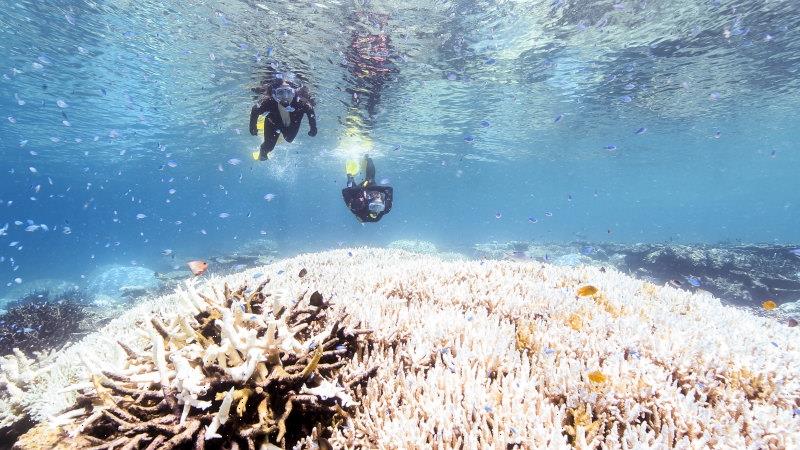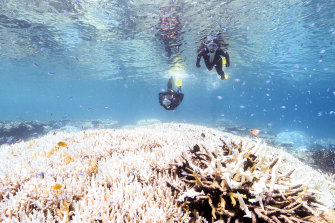A searing late summer heatwave has sent the Great Barrier Reef into the red zone for risk, with scientists warning that high sea surface temperatures could have already caused coral bleaching across vast areas.
The reef covers about 350,000 square kilometres, larger than the UK and Ireland combined. It’s so vast and remote that the agencies which monitor its health won’t know how much bleaching has occurred until they have completed systematic aerial surveys, due by the end of March.
There is a high risk of mass coral bleaching across large areas of the Great Barrier Reef. Credit:Dean Miller/Great Barrier Reef Legacy
Great Barrier Reef Marine Park Authority chief scientist David Wachenfeld said reports of minor to moderate coral bleaching, at locations scattered across the reef, had been coming in for months and now, following the heatwave, he said “the question is how bad will it get and over how big an area?“.
The Bureau of Meteorology is forecasting rain in Far North Queensland by the end of the week, which would lower sea surface temperatures and reduce bleaching risk.
“We’ve had some reports of severe bleaching, but… fewer in number than minor to moderate (bleaching). But the point is that all those minor to moderate bleached corals are already stressed and are going to be further stressed by what we’re seeing now,” Dr Wachenfeld said.
“We do not know whether we will see a continuation of minor to moderate bleaching and then things get better, or will things get worse and by how much?”
Climate change is driving a dramatic increase in coral bleaching, which occurs when the sea surface temperature is too hot for too long.
There have been five mass coral bleaching events since 1998. James Cook University has found only 2 per cent of the entire reef had escaped bleaching in the past 30 years.
Coral bleaching is a political headache for the government heading into a federal election. UNESCO has issued a draft recommendation in June that the Great Barrier Reef should be listed as an “in danger” World Heritage site. A panel of member countries will meet in June to consider the recommendation.
While southeast Queensland and NSW have been flooded from weeks on incessant rain, Far North Queensland has sweltered through its third heatwave of the summer and the hottest start to March on record.
Townsville has hit a late summer high of 37.2 degrees and notched record high overnight temperature records several days in a row. The thermometer has not fallen below 27.3 degrees since the start of the month.
There have been consecutive La Niña weather events in the past two years, which typically bring cooler conditions, coupled with rain and cyclones that cool the water and reduce the risk of bleaching. But Australia has warmed by 1.4 degrees, faster than the global average, and scientists say that climate change means the reef is at risk of bleaching every summer – even during cooler La Niña cycles that used to mean that bleaching was off the cards.
“We’re on bleaching alert every summer now. It doesn’t matter whether it’s an El Niño or La Niña, now that we’re a degree warmer than pre-industrial levels and summers are longer and getting hotter earlier,” said Australian Institute of Marine Science research scientist Neal Cantin.
Dr Cantin said the heatwave was “pushing the heat stress accumulation to points that are likely to cause bleaching” across large areas.
“The entire GBR (Great Barrier Reef) is hot, particularly in the central GBR between Townsville and Cairns. South down to the Whitsundays is hot as well, and the far north Torres Strait is particularly hot. So we’re looking at two-thirds of the system is hotter than it should be.”
A guide to the environment, what’s happening to it, what’s being done about it and what it means for the future. Sign up to our fortnightly Environment newsletter here.
Most Viewed in Politics
From our partners
Source: Read Full Article

